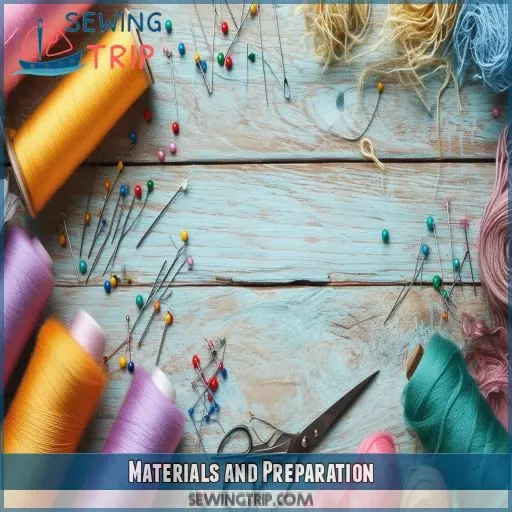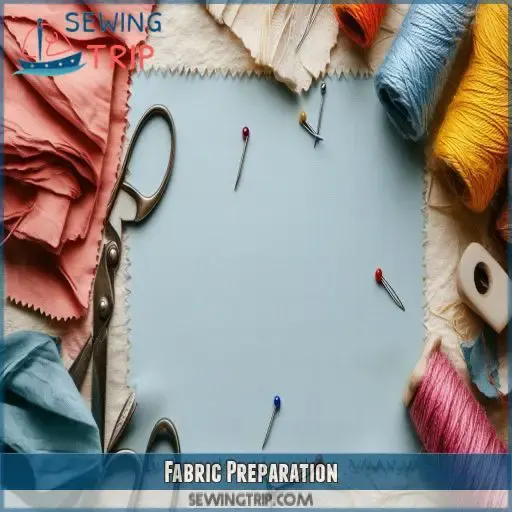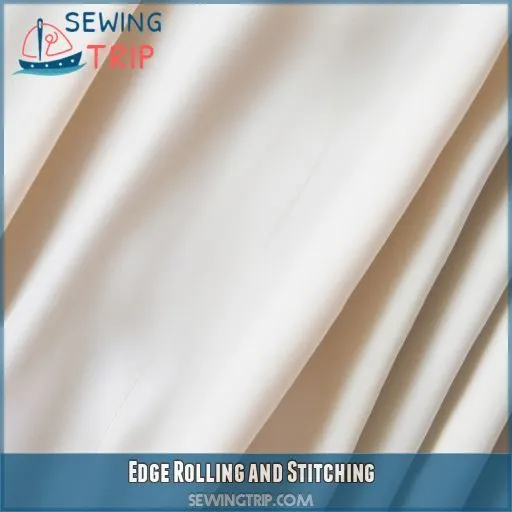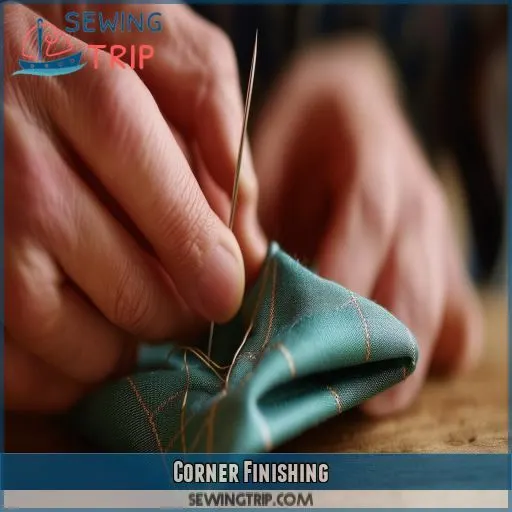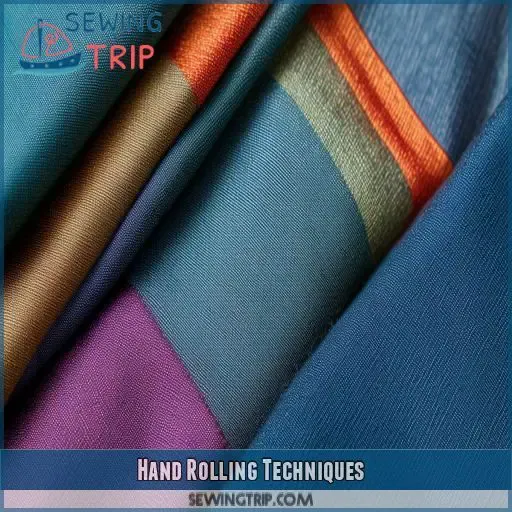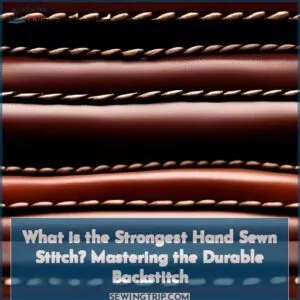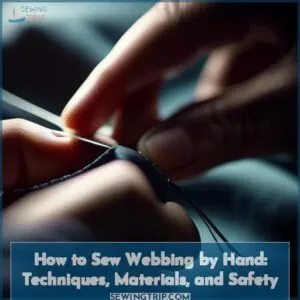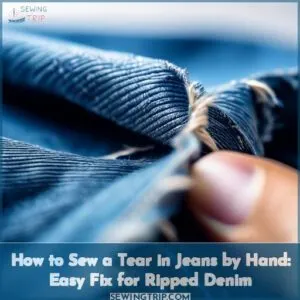This site is supported by our readers. We may earn a commission, at no cost to you, if you purchase through links.
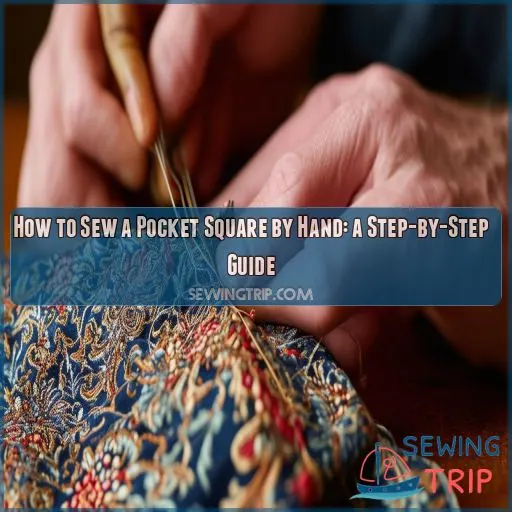 Unleash your creativity and craftsmanship with our comprehensive guide on how to sew a pocket square by hand. This step-by-step tutorial will walk you through the process, from preparing the materials to achieving a professional finish.
Unleash your creativity and craftsmanship with our comprehensive guide on how to sew a pocket square by hand. This step-by-step tutorial will walk you through the process, from preparing the materials to achieving a professional finish.
Whether you’re a seasoned sewer or a beginner, this guide is designed to enhance your sewing skills and help you navigate the complexities of pocket square creation. It’s not merely a craft; it’s a bespoke art form that underpins the world of tailored fashion.
So, let’s embark on this journey towards mastery and innovation.
Table Of Contents
Key Takeaways
- Use a medium-weight cotton fabric for your pocket square.
- Iron the fabric to remove wrinkles before starting the sewing process.
- Mark a line ½ inch from each edge of the fabric and roll the top right corner tightly.
- Sew along the guideline, alternating with slip stitches inside the rolled edge, and knot the thread at the end of the stitches. Repeat on the opposite edge, tucking in the rolled edge when rolling the top left corner and tacking the corner into place with stitches.
How to Sew a Pocket Square by Hand ?
To sew a pocket square by hand, start by cutting a square of fabric, folding the edges, and sewing along the creases to create a neat finish. This process involves careful folding, pressing, and stitching to achieve a handmade pocket square.
Materials and Preparation
To sew a pocket square by hand, you’ll need the following materials:
- Medium weight cotton fabric
- Iron
- Needle
- Thread
- Chalk, marking pen, or pencil
- Scissors or rotary cutter and cutting board
- Long fine sharp pins (especially for silk or satin) or sewing clips
The fabric should be pressed to remove wrinkles before cutting a square with an additional 1 inch for rolled edges. Mark a line ½ inch from each edge with a chalk, marking pen, or pencil. Choose a needle size based on the fabric weight and thread color to match the fabric. Cut thread twice the length of the square edge.
To edge roll and stitch, roll the top right corner of the fabric tightly and stitch along the guideline, alternating with slipstitches inside the rolled edge. Knot the thread at the end of the stitches. Repeat on the opposite edge.
For corner finishing, tuck in the rolled edge when rolling the top left corner, tack the corner into place with stitches, sew the rest of the edge as before, and tack the opposite corner and knot the stitches.
Hand rolling techniques involve softly turning the edge over with a hand-held needle, inserting small stitches approximately ½ to 1 centimeter apart around the edge, rolling the edge into a cylinder, and mitering the corners for a professional finish.
Each hand-rolled pocket square is individual and unique, with precision and care given to create a one-of-a-kind piece that enhances the overall appearance of a suit or jacket.
Medium Weight Cotton Fabric
When choosing your fabric for that dapper pocket square, think of it as the canvas for your sartorial expression. Here’s what you’ll need:
- A swatch of medium weight cotton, the Goldilocks of natural fibers—not too heavy, not too light.
- Thread size that’s akin to a secret handshake with your fabric weight; they’ve got to get along.
- Color selection and pattern matching that shout style maestro without uttering a word.
Iron
When it comes to ironing a pocket square, the process is quite straightforward. Start by pressing the fabric to remove any wrinkles. Then, measure and mark a line ½ inch from each edge using a chalk, marking pen, or pencil. Next, cut a square of fabric with an additional 1 inch for rolled edges.
For ironing, you’ll need a clear ruler and a chalk pencil. Roll the top right corner of the fabric tightly and stitch along the guideline, alternating with slipstitches inside the rolled edge. Knot the thread at the end of the stitches. Repeat this process on the opposite edge.
When it comes to corner finishing, tuck in the rolled edge when rolling the top left corner and tack the corner into place with stitches. Sew the rest of the edge as before, then tack the opposite corner and knot the stitches.
Needle
Needles are an essential tool when it comes to sewing a pocket square by hand. They come in various shapes, sizes, and gauge, each designed for specific materials and stitching techniques. When choosing a needle for your pocket square, consider the following factors:
- Needle Gauge: The gauge refers to the thickness of the needle. Lower numbers indicate a thinner needle, while higher numbers indicate a thicker needle. For sewing a pocket square, a fine needle with a gauge of 9-12 (65-80) is generally recommended for most fabrics.
- Needle Shape: Different needle shapes are designed for specific stitching techniques. A sharp needle point is ideal for sewing through multiple layers of fabric, while a ballpoint needle is better for sewing through thicker fabrics without damaging them.
- Needle Size: The size of the needle depends on the thickness of the fabric you’re working with. For lightweight fabrics like silk and cotton, a smaller needle size is suitable, while for heavier fabrics like wool, a larger needle size may be necessary.
- Needle Threader: A needle threader is a small tool used to thread a needle. It can be especially useful when working with fine threads or when your eyesight isn’t as good as it once was.
When it comes to sewing a pocket square, you’ll need a needle that’s suitable for the fabric you’re using and the stitching technique you plan to employ. For example, if you’re using a lightweight fabric like silk, a fine needle with a gauge of 9-12 (65-80) and a sharp needle point would be a good choice. If you’re using a thicker fabric like wool, a larger needle size and a ballpoint needle may be more appropriate.
Thread
Choosing the right thread for your hand-sewn pocket square is crucial for achieving a professional finish. Here are four essential factors to consider when selecting thread for your project:
- Thread count: The thread count refers to the number of threads woven into a square inch of fabric. Higher thread counts typically result in smoother, more durable fabrics. For a pocket square, a medium weight cotton fabric with a moderate thread count is suitable.
- Thread color: Choose a thread color that matches the border color of your pocket square. This will ensure a seamless blend and a cohesive look. If you’re using a lightweight material like silk, you may want to opt for a thread color that’s slightly lighter to prevent the thread from showing through.
- Thread tension: The tension of the thread can affect the overall appearance of your stitching. Aim for a moderate tension that provides enough give for fluid stitches but isn’t so loose that it causes puckering. Practice your stitching on a scrap piece of fabric to find the optimal tension for your project.
- Thread type: Consider the type of thread that will work best for your pocket square. For a classic, understated look, choose a thread that matches the fabric’s texture and weight. For a more decorative touch, consider using a contrasting thread color or a specialized thread like metallic or embroidery thread.
Chalk, Marking Pen, or Pencil
When it comes to marking your fabric for a hand-sewn pocket square, you have several options. Chalk, marking pens, and pencils are all suitable for this purpose. Here’s a brief overview of each:
- Chalk: This is a traditional and widely available fabric marker. It’s made of clay-based chalk and can be removed easily by rubbing or ironing over the marks. However, it can be fragile and prone to breaking or crumbling over time.
- Chalk Pencils: These are slightly waxier than tailor’s chalk, making them stay on the fabric for longer. They’re also more accurate due to their sharpenable tips. Chalk pencils are available in various colors and can create fine lines.
- Marking Pens: There are several types of pens available for marking fabric. Heat-erasable pens, for example, can be used on a variety of colors and are easy to remove with heat, but they may not be suitable for all fabrics. Water-soluble pens create a fine line and are accurate but can only be used on fabrics that won’t be stained by water.
When choosing a marking tool, consider the fabric type and the purpose of the markings. For example, if you’re marking a pocket square, you might prefer a tool that creates a fine line and is easy to remove, as you’ll be sewing the fabric shortly after marking. If you’re marking a pattern for a garment that won’t be sewn immediately, a tool that stays on the fabric for longer might be more suitable.
Remember to always test your chosen marking tool on a scrap piece of the same fabric before using it on your project to ensure it won’t leave any unwanted residue or stains.
Scissors or Rotary Cutter and Cutting Board
After marking your fabric, you’ll need to cut it precisely. Here’s where your choice of scissors or rotary cutters and cutting mats comes into play.
- Rotary cutters glide through fabric like butter, ensuring clean cuts.
- Scissors offer a hands-on feel, perfect for those who love the snip-snap rhythm.
- Cutting mats protect surfaces and guide your cuts, making every slice count.
Choose your weapon wisely!
Long Fine Sharp Pins (especially for Silk or Satin) or Sewing Clips
When working with delicate fabrics like silk or satin, long fine sharp pins or sewing clips are essential tools for your sewing kit. These materials are designed to handle the specific needs of these fabrics, ensuring a smooth and successful sewing process.
Long fine sharp pins, such as Dritz 21 Satin Pins, are ideal for light to medium weight fabrics. They’ve a tapered point, making them perfect for piercing through delicate materials without causing damage. The extra-long length allows for better control and precision when pinning, while the reusable plastic storage box ensures that the pins are easily accessible and organized.
Sewing clips, on the other hand, are a great alternative to pins on projects where you don’t want to use pins, such as laminate, leather, vinyl, silk, or satin. They’re loved by quilters for clipping binding in place when preparing to sew it up. Sewing clips, like those from Love Sew, are fast and painless, and they can hold layered sections without distortion. They aren’t too big, so they don’t get in the way, and they’ve flat backs and flat sides, which help to keep the hem or edge flat, preventing puckering or wrinkling.
In the realm of hand-sewn pocket squares, the choice between pins and clips depends on the specific requirements of the project. Pins are essential for tasks like adding a chest pocket to a shirt or anything else that’s placed away from the sewing machine. They’re also preferred for precisely holding thin sliding layers together, for easing in gathered areas, and for positioning zippers. Clips, on the other hand, are great for holding folded hems, for fitting, and for holding together layers you’re serging. They’re also useful for millinery work and edge binding.
In conclusion, long fine sharp pins and sewing clips are essential tools for working with delicate fabrics like silk or satin. Both have their unique advantages and are designed to enhance your sewing experience. Choose the one that best suits your project and sewing style, and remember to always remove the pins or clips right before you get to the presser foot on your machine.
Fabric Preparation
To prepare your fabric for sewing a hand-rolled pocket square, follow these steps:
- Press the fabric to remove wrinkles: Iron the fabric to ensure it’s smooth and free of creases. This will make it easier to work with and ensure a neat and professional finish.
- Cut a square of fabric with an additional 1 inch for rolled edges: Measure and cut a square of fabric using scissors or a rotary cutter and mat. Make sure to add an extra inch to each side to accommodate the rolled edges.
- Mark a line ½ inch from each edge: Use a chalk, marking pen, or pencil to draw a line ½ inch from each edge of the square. This will serve as a guide for your stitching and ensure that the rolled edges are consistent in size.
Remember to choose a medium weight cotton fabric for your pocket square, as it’s the best material for hand-rolling and provides a good balance between drape and structure. Make sure to press the fabric before cutting and marking, as this will help remove any wrinkles and ensure a smooth finish.
Press the Fabric to Remove Wrinkles
Pressing your fabric is a crucial step in the process of sewing a pocket square. It ensures that the fabric is wrinkle-free and ready for stitching. Here’s how you can press your fabric to remove wrinkles:
- Iron the Fabric: Start by ironing your fabric to remove any existing wrinkles. Use a medium-hot iron and a clean, dry cloth to protect the fabric from direct heat.
- Press the Edges: Press the edges of the fabric to remove any wrinkles or creases. This will ensure that the edges are smooth and ready for stitching.
- Press the Center: Press the center of the fabric as well. This will help to remove any wrinkles that may have formed during the cutting process.
- Check for Creases: Inspect the fabric for any remaining creases. If you find any, press them out with the iron.
- Let it Cool: Allow the fabric to cool before handling it further. This will prevent any accidental wrinkles from forming.
Cut a Square of Fabric With an Additional 1 Inch for Rolled Edges
To create a hand-rolled pocket square, you’ll need to cut a square of fabric with an additional 1 inch on all sides for the rolled edges.
This extra allowance will ensure that the edges are properly rolled and stitched, giving the pocket square a professional and polished look.
The fabric should be cut with precision, as the accuracy of the cut will directly impact the quality of the finished product.
Mark a Line ½ Inch From Each Edge With a Chalk, Marking Pen, or Pencil
Now that you’ve cut your square, it’s time to mark a line ½ inch from each edge using a chalk, marking pen, or pencil.
This line serves as a guide for your stitching. Remember, the thickness of your fabric and the size of your stitches will affect the tension, so be meticulous.
For corner reinforcement, consider using a needle and thread to tack the corners into place before sewing the rest of the edge.
Edge Rolling and Stitching
Now, let’s focus on the crucial step of edge rolling and stitching. You’ll roll the top right corner tightly, stitch along the guideline with slipstitches inside the rolled edge, and secure your work with a knot at the end.
Roll the Top Right Corner of the Fabric Tightly
When you embark on the journey of hand-sewing a pocket square, the first step is crucial – rolling the top right corner of the fabric tightly.
This meticulous process sets the foundation for a flawless finish. Imagine delicately coaxing the fabric into a neat roll, ensuring each stitch is purposeful and secure.
It’s like crafting a masterpiece, where every detail matters, and precision reigns supreme. So, take your time, enjoy the artistry, and let your hands work their magic!
Stitch Along the Guideline, Alternating With Slipstitches Inside the Rolled Edge
In the meticulous art of hand-sewing a pocket square, the next step after rolling the top right corner tightly is to stitch along the guideline.
This involves delicately alternating between regular stitches and slipstitches inside the rolled edge. By carefully following this process, you ensure a secure and polished finish to your pocket square, showcasing your attention to detail and craftsmanship.
Knot the Thread at the End of the Stitches
To knot the thread at the end of the stitches when hand rolling a pocket square, follow these steps:
- Thread the needle: Ensure the thread is the appropriate length for the fabric thickness and needle size.
- Tie a knot: Create a knot with the thread, ensuring it’s secure and won’t come undone during the stitching process.
- Thread the needle: Pass the thread through the eye of the needle.
- Stitch: Begin stitching along the guideline, using a slipstitch to secure the rolled edge.
- Repeat: Continue stitching around the perimeter of the square, knotting the thread at the end of each stitch.
Remember to keep the thread tension consistent and maintain a steady stitch length for a professional finish.
Repeat on the Opposite Edge
Now, it’s time to repeat the process on the opposite edge of your pocket square. Remember, the rolled edge is your guide.
Insert slipstitches inside the roll, and stitch along the guideline. Knot the thread at the end of the stitches. This process ensures a neat and professional finish.
Don’t forget to tack the corners into place for a perfect mitered corner.
Corner Finishing
To finish the corners of your hand-rolled pocket square, follow these steps:
- When rolling the top left corner, tuck in the rolled edge.
- Tack the corner into place with stitches.
- Sew the rest of the edge as before.
- Tack the opposite corner and knot the stitches.
These steps will ensure a professional finish for your hand-rolled pocket square.
Tuck in the Rolled Edge When Rolling the Top Left Corner
Tuck in the rolled edge when rolling the top left corner. This step is crucial for achieving a mitered finish. Here’s what to do:
- Roll the top left corner tightly.
- Tuck the rolled edge under the corner.
- Sew the corner in place with hidden stitches.
- Repeat on the opposite corner.
By following these steps, you’ll create a tight roll and maintain the shape of your pocket square.
Tack the Corner Into Place With Stitches
To tack the corner into place with stitches, you’ll need a needle and thread that matches the color of your fabric. Start by inserting the needle through the corner, just above the rolled edge. Then, bring the needle back up through the fabric about 1/4 inch away from the first stitch, creating a loop. Repeat this process, inserting the needle through the corner and then back up through the fabric at a slightly different angle, creating a series of small stitches that secure the corner in place. This technique allows you to maintain the shape of the corner while sewing around it.
Remember to keep the stitches consistent in size and spacing for a neat finish. You may need to adjust your needle or thread tension to achieve the desired look. Once you’ve completed the stitching around the corner, you can move on to the next step in the pocket square-making process.
Sew the Rest of the Edge as Before
To sew the rest of the edge as before, you’ll need to follow the steps outlined in the tutorial.
For a hand-sewn pocket square, you’ll need to tuck in the rolled edge when rolling the top left corner, tack the corner into place with stitches, and sew the rest of the edge as before.
This involves sewing the pocket square along the guideline, alternating with slipstitches inside the rolled edge, and knotting the thread at the end of the stitches.
Repeat these steps on the opposite edge to complete the hand-rolling process.
Tack the Opposite Corner and Knot the Stitches
To finish the pocket square, you’ll need to tack the opposite corner and knot the stitches. This involves using tacking techniques to secure the rolled edge in place, ensuring a neat and professional finish.
Choose a needle gauge and stitch length appropriate for your fabric, and remember to make hidden stitches for a seamless look.
With these steps, you’ll have a bespoke pocket square that’s designed to enhance your suit or jacket.
Hand Rolling Techniques
To hand roll a pocket square, you’ll need a hand-held needle, a piece of fabric, and a matching thread.
Start by softening the edge of the fabric with the needle, then insert small stitches approximately ½ to 1 centimeter apart around the edge.
Roll the fabric into a cylinder, and the stitches will be hidden within the rolled edge.
To maintain a professional finish, miter the corners of the pocket square.
Edge is Softly Turned Over With a Hand-held Needle
To create a hand-rolled pocket square, you’ll need to carefully turn the edge of the fabric over with a hand-held needle. Start by rolling the top right corner of the fabric tightly and stitching along the guideline, alternating with slipstitches inside the rolled edge. Knot the thread at the end of the stitches and repeat on the opposite edge.
For corner finishing, tuck in the rolled edge when rolling the top left corner, tack the corner into place with stitches, and sew the rest of the edge as before. Tack the opposite corner and knot the stitches.
Small Stitches Are Inserted Approximately ½ to 1 Centimeter Apart Around the Edge
Small stitches play a crucial role in the art of hand-rolling pocket squares, adding finesse and durability to the finished product.
As you continue your journey into crafting these exquisite accessories, remember to insert these tiny stitches approximately ½ to 1 centimeter apart around the edge.
Each stitch contributes to the supple yet prominent border, ensuring a professional finish that sets hand-rolled pocket squares apart from machine-hemmed ones.
So, thread your needle with care and let each stitch tell a story of craftsmanship and attention to detail.
Edge is Rolled Into a Cylinder
When hand-rolling the edge of a pocket square, the fabric is delicately turned over with a hand-held needle, ensuring a soft and precise finish.
Small stitches, spaced approximately half to one centimeter apart, are then carefully inserted around the edge.
This meticulous process results in the edge being rolled into a cylinder shape, creating a supple yet prominent border that adds a touch of elegance to the pocket square.
Thread is Not Seen as a Feature of the Design
As you navigate the complexities of hand-rolling your pocket square, remember that the thread shouldn’t be seen as a feature of the design. Instead, it underpins the cylinder shape and mitered finish.
Using a hand-held needle, insert small stitches approximately ½ to 1 centimeter apart around the edge. Once the edge is rolled into a cylinder, the thread becomes invisible, enhancing the overall appearance of your bespoke piece.
Corners Are Mitered for a Professional Finish
To ensure a professional finish when hand rolling pocket squares, mitering the corners is crucial. Here’s how:
- Twist two sides together when reaching a corner.
- Continue stitching per normal.
- Improvise stitches on corners to maintain shape.
- Mitered corners provide a sleek and durable finish.
These techniques, combined with the right materials and attention to detail, will result in a superior finish that’s both elegant and durable.
Frequently Asked Questions (FAQs)
Can I use patterned fabric for a pocket square?
Absolutely, you can use patterned fabric for a pocket square. In fact, patterned pocket squares can add a unique touch to your outfit and showcase your personal style.
When choosing a patterned fabric, consider the colors and patterns that complement your suit or jacket. For example, if you’re wearing a striped shirt, you might choose a pocket square with a solid color that contrasts with the stripes. If your suit is solid, you could opt for a pocket square with a subtle pattern or a contrasting color.
How do I choose the best fabric weight?
To choose the best fabric weight for your pocket square, consider the following factors:
- Comfort: Lightweight fabrics are generally more comfortable to wear, as they allow for better airflow and are less likely to trap heat. Heavier fabrics can be more stifling, and may be less comfortable in warmer weather.
- Durability: Heavier fabrics are generally more durable and long-lasting, as they’re less likely to wear down or show signs of age over time. Lighter fabrics may be more prone to damage, and may need to be replaced more frequently.
- Appearance: The weight of the fabric can also affect the overall appearance of the pocket square. Heavier fabrics tend to drape more gracefully, creating a more elegant and formal look. Lighter fabrics can be more casual and relaxed, and may be better suited to less formal occasions.
- Personal preference: Ultimately, the weight of the fabric comes down to personal preference. Some people may prefer the look and feel of a heavier, more substantial fabric, while others may prefer something lighter and more breathable.
- Occasion: The weight of the fabric can also depend on the occasion for which the pocket square will be worn. For more formal events, a heavier fabric may be more appropriate, as it will create a more elegant and refined look. For more casual occasions, a lighter-weight fabric may be a better choice.
When choosing the fabric weight for your pocket square, consider these factors and choose a weight that best suits your needs and preferences.
What are the alternatives to silk and linen?
For an alternative to silk and linen, consider using wool or cotton fabric for your pocket square.
Wool is a refined and sophisticated choice, often used for more formal occasions, while cotton is more casual and versatile.
Wool pocket squares are ideal for refined woolen suits, providing a cohesive look.
On the other hand, cotton pocket squares are suitable for casual outfits and can be matched with cotton or linen suits.
How do I care for and clean hand-sewn pocket squares?
To care for and clean hand-sewn pocket squares, hand wash delicate fabrics like silk in cold water with mild soap, air dry, and iron on low heat. For sturdier materials like cotton, machine wash on gentle cycle.
Are there different styles of folds for pocket squares?
Yes, there are various styles to fold pocket squares, each adding a unique touch to your outfit. From the classic Presidential Fold to the intricate Winged Puff, explore different folds to elevate your look effortlessly.
Conclusion
Embark on a journey of craftsmanship and creativity with our step-by-step guide on how to sew a pocket square by hand.
From fabric preparation to hand rolling techniques, this comprehensive tutorial ensures precision and attention to detail in every stitch.
Elevate your sewing skills and achieve a professional finish with the FOCUS KEYWORD: sewing a pocket square by hand.
Let your creativity flourish as you master this bespoke art form in tailored fashion.

